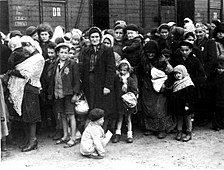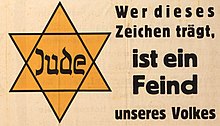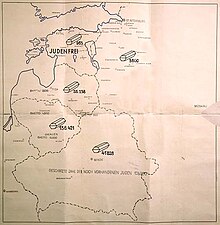Judenfrei
| Part ofa serieson |
| The Holocaust |
|---|
 |




Judenfrei(German:[ˈjuːdn̩ˌfʁaɪ],"free of Jews" ) andjudenrein(German:[ˈjuːdn̩ˌʁaɪn],"clean of Jews" ) are terms ofNazi originto designate an area that has been "cleansed"ofJewsduringThe Holocaust.[1] Whilejudenfreirefers merely to "freeing" an area of all of its Jewish inhabitants, the termjudenrein(literally "clean of Jews" ) has the even stronger connotation that any trace of Jewish blood had been removed as an alleged impurity in the minds of the criminal perpetrators.[2]These terms ofracial discriminationandracial abuseare intrinsic to Nazianti-Semitismand were used by theNazisin Germany beforeWorld War IIand in occupied countries such asPolandin 1939.Judenfreidescribes the local Jewish population having been removed from a town, region, or country by forced evacuation during the Holocaust, though many Jews were hidden by local people. Removal methods included forced re-housing inNazi ghettosespecially ineastern Europe,and forced removal orResettlement to the Eastby German troops, often to their deaths. Most Jews were identified from late 1941 by theyellow badgeas a result of pressure fromJoseph GoebbelsandHeinrich Himmler.
Following the defeat of Germany in 1945, some attempts have been made to attract Jewish people back to Germany, as well as reconstructsynagoguesdestroyed during and afterKristallnacht.The termsjudenreinandjudenfreihave since been used in the persecution of global Jewish communities or the nation ofIsrael.
Locations declaredjudenfrei
[edit]Establishments, villages, cities, and regions were declaredjudenfreiorjudenreinafter they were apparentlyclearedof Jews. However, some Jewish people survived by being hidden and sheltered by friendly neighbours. InBerlin,they were known as "submariners" since they seemed to have disappeared (under the waves). Many survived the end of the war, hence becomingHolocaust survivors.
- Gelnhausen,Germany andCalw,Germany – reportedjudenfreion November 1, 1938, by propaganda newspaperKinzigwachtafter their synagogues were closed and remaining local Jews forced to leave the towns.[3]
- German-occupiedBydgoszcz(Poland) – reportedjudenfreiin December 1939.[citation needed]
- German-annexedAlsace– reportedjudenreinbyRobert Heinrich Wagnerin July 1940.[4]
- Banat,German-occupied territory of Serbia– reportedjudenfreion 19 August 1941 inVölkische Beobachter(lit.People's Observer).[5]On 20 August 1941 Banat was declaredjudenfreiby its German administrators.[6]
- German-occupiedLuxembourg– reportedjudenfreiby the press on October 17, 1941.[7]
- German-occupiedEstonia– December 1941.[8]Reported asjudenfreiat theWannsee Conferenceon January 20, 1942.[9]
- Independent State of Croatia– Declaredjudenfreiby Interior MinisterAndrija Artukovićin February 1942 but Germany suspected that this was not true and the authorities from Berlin sentFranz Abromeitto assess the situation. After that, theUstašewere under pressure to finish the job. In April 1942 two hundred Jews fromOsijekwere deported toJasenovac,while 2,800 were sent toAuschwitz.[10]TheGestapoorganized the deportation to Auschwitz of the lastCroatian Jewsin May 1943, 1,700 fromZagreband 2,500 from other parts of theNDH.[11][12]: 107 German diplomatSiegfried Kaschepronounced Croatiajudenfreiin a message to Berlin on 18 April 1944, stating that "Croatia is one of the countries in which the Jewish problem has been solved".[13][14]
- German-occupied territory of Serbia/ Belgrade – May 1942, reported in the SS-StandartenführerEmanuel Schäfercable sent to theReich Security Main Officein Berlin; Schäfer was theDer Befehlshaber der SIPO und des SDhead at that time inBelgrade,[15][16][17][18]while in June 1942 he reported to his supervisors that"Serbien ist Judenfrei"(lit. "Serbia is free of Jews" ).[12]: 3 In August 1942,Harald Turnerreported to the German commander in theBalkansthatSerbiawas the first European territory where the "Jewish problem"was solved.[19][20]: 118
- Vienna– reportedjudenfreibyAlois Brunneron October 9, 1942.
- Berlin,Germany – May 19, 1943.[21]
- Erlangen,Germany was declaredjudenfreiin 1944.
See also
[edit]References
[edit]- ^Scheffler, Wolfgang (2007)."Judenrein".Encyclopaedia Judaica(2 ed.). Thomson Gale.
- ^"Aryanization: Judenrein & Judenfrei".shoaheducation.com.Archived fromthe originalon March 6, 2017.RetrievedMarch 6,2017.
- ^"'Gelnhausen endlich judenfrei': Zur Geschichte der Juden während der Nationalsozialistischen Verfolgung "['Gelnhausen finally free of Jews': On the History of the Jews during the Nazi persecution](PDF)(in German). Archived fromthe original(PDF)on September 28, 2007.
- ^Blumenkranz, Bernhard; Catane, Moshe (2007)."Alsace".Encyclopaedia Judaica(2 ed.). Thomson Gale.
- ^Drndić, Daša (2009).April u Berlinu.Fraktura. p. 24.ISBN978-953-266-095-1.
Njemački list Völkische Beobachter objavio je 19. kolovoza 1941. da je Banat konačno Juden frei.
- ^Muth, Thorsten (2009).Das Judentum: Geschichte und Kultur.Pressel. p. 452.ISBN978-3-937950-28-0.
Am 20. August konnte die deutsche Führung das Banat für Judenfrei "erklären.
- ^"Commémoration de la Shoah au Luxembourg"[Commemoration of the Shoah in Luxembourg] (in French). Government of Luxembourg. July 3, 2005. Archived fromthe originalon September 30, 2007.
- ^"Extract from Report by Einsatzgruppe A".Archived fromthe originalon November 12, 2007.Partial Translation of Document 2273-PS Source: Nazi Conspiracy and Aggression, Vol. IV. USGPO, Washington, 1946, pp. 944–949
- ^"Estonian Jews".Simon Wiesenthal Center.Archived fromthe originalon September 28, 2007.sourced toEncyclopedia of the Holocaust.New York: Macmillan Publishing Company. 1990.
- ^Subotić, Jelena (2019).Yellow Star, Red Star: Holocaust Remembrance after Communism.Ithaca, New York: Cornell University Press. p. 106.ISBN978-1-50174-241-5.
- ^Bulajić, Milan (2002).Jasenovac: the Jewish Serbian holocaust (the role of the Vatican) in Nazi-Ustasha Croatia (1941-1945).Fund for Genocide Research. p. 222.ISBN9788641902211.
- ^abSubotić, Jelena (2019).Yellow Star, Red Star: Holocaust Remembrance after Communism.Cornell University Press.ISBN9781501742415.
- ^Jewish History of Yugoslavia,porges.net; accessed 5 May 2016.
- ^"Povijest Židova Jugoslavije"(in French). Porges.net.RetrievedAugust 12,2015.
- ^Lituchy, Barry M. (2006).Jasenovac and the Holocaust in Yugoslavia: analyses and survivor testimonies.Jasenovac Research Institute. pp. xxxiii.ISBN978-0-97534-320-3.
- ^Manoschek, Walter (1995)."Serbien ist judenfrei": militärische Besatzungspolitik und Judenvernichtung in Serbien 1941/42.Walter de Gruyter. p. 184.ISBN9783486561371.
- ^Lebel, G'eni (2007).Until "the Final Solution": The Jews in Belgrade 1521 - 1942.Avotaynu. p. 329.ISBN9781886223332.
- ^Herbert, Ulrich; Schildt, Axel (1998).Kriegsende in Europa.Klartext. p. 149.ISBN9783884745113.
- ^John K. Cox; (2002)The History of Serbiap. 92-93; Greenwood,ISBN0313312907
- ^Prusin, Alexander (2017).Serbia Under the Swastika: A World War II Occupation.Urbana, Illinois: University of Illinois Press.ISBN978-0-252-09961-8.
- ^"Was war am 19. Mai 1943"[What was on May 19, 1943] (in German). chroniknet.
